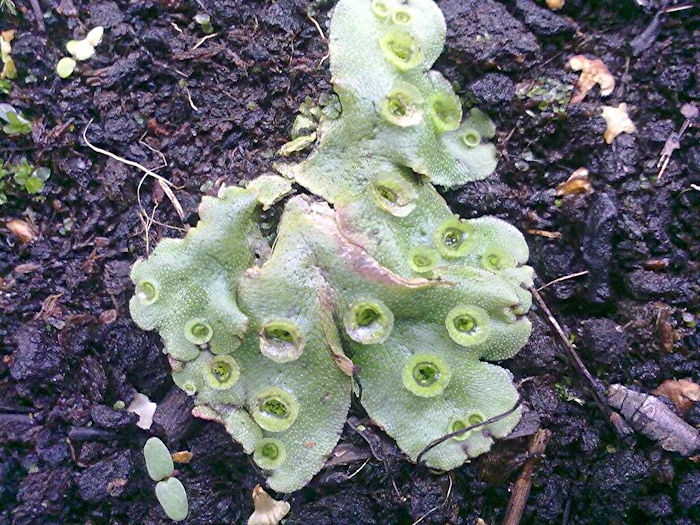| |
|
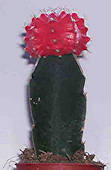
Photo: Lewis Coulson 2007 |
Grafted cactus
These curiousities are not one organism, but one cactus grafted onto another. The red top is a mutant Gymnocalycium, unable to make chlorophyll and therefore entirely dependent on the lower green grafting stock. Several species are sold as red grafts including G. mihanovichii cv. hibotan and G. stenopleurum, perhaps explaining the range of pinks that are seen among such grafts. An elongated yellow grafted cactus is also seen that is probably a chlorophyll-deficient Chamaocereus silvestrii Syn. Syn. Echinopsis chamaecereus. The green stock is often an epiphytic cactus such as Epiphyllum or Hylocereus. Personally, I don't like these grafts but it's the only way to propagate thse mutations. They must be quite popular as they are widely stocked by garden centres.
|

Photo: Robert Bendesky 2005 |

Photo: Robert Bendesky 2005 |
Rhipsalis salicorniodes
which has barrel-shaped joints growing into a single stem. This is an epiphytic cactus from the rain forests of South America and needs more frequent watering and humidity than most desert cacti.
This species is very similar to R. bambuscoides which has club-shaped joints.
|
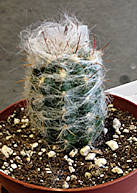
Photo: Ell Pinay 2016 |
Hairy Cactus
This is an example of an Oreocereus from the high Andes of South America. The white hairs are vestigial spines and perfectly natural. In its habitat the hairs provide some protection from the strong sunlight at those altitudes and act as nucleation centres to condense scarce moisture from mists.
Many species of cacti have a covering of woolly hairs protecting their body from strong sunglight. They are best watered from below by putting their pot in a dish of water to avoid the hairs becoming discoloured by wicking up salts.
|
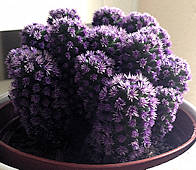
Photo: Andrea Hüper 2014 |
Kosmic Kaktus
A range of cacti with brightly-dyed spines (purple, blue, red, green and yellow) sold under the brand: "Kosmic Kakus." This one is a Mammillaira gracilis, possibly the cultivar "Arizona Snowflake," which would naturally have gleaming white spines and small yellow flowers. Should the plant grow, any new growth will also have white spines. I'm not sure that customers are always aware of this.
There is also a range of dyed rosulate succulents e.g. Echeveria shaviana that would normally have lovely pinkish-grey rosettes which will develop should the plant grow offsets. Personally, I'm appalled that anyone would do this to a cactus or succulent plant.
|
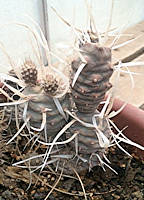
Photo: Farmer Matt 2015 |
Tephrocactus articulatus var. papyracanthus
A cactus with a well-jointed grey-body offset by white papery spines with glochids at their base. In my experience, the spines are not as harmless as they appear.
Native to Argentina.
See: The Cactus Page for more information and a wider range of choice and easy to flower cacti.
|
 |
| |
This group of succulents from Southern Africa includes the "Living Stone" mimicry plants that disguise themselves to resemble the pebbles among which they live.
See: more Mesembs
|
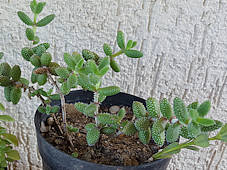
Photo: Nancy Chan |
Delosperma echinatum Schwantes 1927
This shrubby Mesemb forms a sprawling clump of thin, woody stems, up to 18 in high. The younger stems and ovate succulent leaves are covered in tiny pustules with hairs that tend to rub off easily. Small white to yellow flowers are produced in the Spring.
Native to South Africa.
See: more Delospermas
|
 |
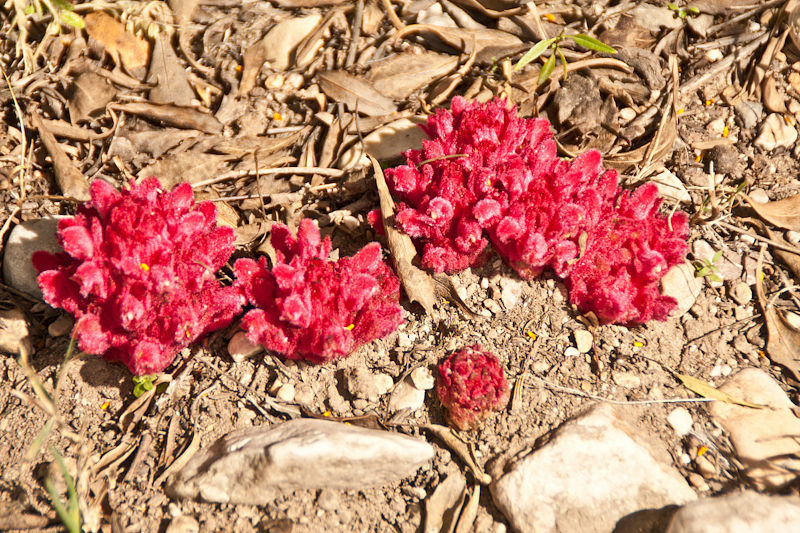 |
Hyobanche sanguinea Linnaeus 1771 (Red Broomrape, Inkblom, Jakkalsblom)
the flower of a leafless parasitic plant that lives as underground rhyzomes obtaining sustenance from roots of other plants.
Native to South Africa. Not a succulent plant, but a spectacular find. This is the type species for the genus.
Photo: Dr Adriaan S van den Berg
|
 |
| |
See: The Kalanchoe Page for more information and a wider range of Kalanchoes. These popular leafy suculents are mostly easy to grow on a sunny window ledge. However, Kalanchoe leaves (technically phylloclades) may contain toxic bufadienolides and must not be fed to livestock.
|
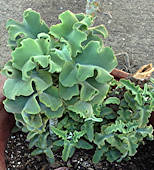 
Photo: Scot Corrigan 2014 |
Kalanchoe beharensis Drake 1903
A shrubby plant with a long grey-brown stem, made knobbly by leaf scars with sharp projections. Towards the ends of the stems are a few large, felted deltoid leaves with undulate margins. The leaf surface has white to brownish pubescence.
The inflorescence is a panicle of many, small, pink to greenish-yellow flowers.
Native to dry forests of Southern Madagascar. Needs restarting regularly to look its best.
Left: Makes a fine specimen plant in a warm climate or conservatory.
|
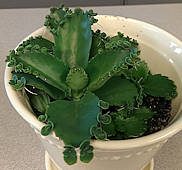
Photo: Kathy Bender 2014 |
Left: Kalanchoe daigremontiana (Bryophyllum daigremontiana)
Common names: Alligator Teardrop Plant, Flea Plant, mother of thousands.
An easily grown Kalanchoe for a sunny window ledge. Small plantlets form on the serrated leaf margins, drop off, and grow in any nearby plant pot. A large plant produces a cluster of orange flowers, which should be cut off after the flower is finished or the plant will die.
|
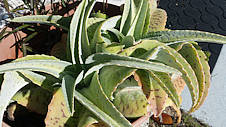
Photo: Kenneth Butler |
Kalanchoe gastonis-bonnieri Raymond-Hamet & H. Perrier 1912 (Donkey Ears)
Named for: Dr. Gaston Bonnier (1853-1922) French botanist
A fast-growing succulent with large greenish to bronzed ovate to lancolate leaves covered with white farina to give a glaucous appearance and marked with flecks of purple. The serrate leaf margins develop occasional plantlets.
Native to Northern Madagascar.
|
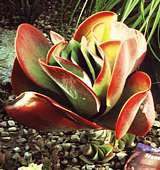
Photo: Ivo Polach. |
Left: Kalanchoe luciae
Common names: Flapjack Plant
A choice plant for a sunny position in a frost-free climate. In the shade, the leaves will go a boring green. This species tends to colour up naturally in full sun, but there is a particularly red cultivar called "Red Flapjack".
The rather similarly shaped Kalanchoe thrysiflora has glaucous green leaves with a farinose coating, but the two species are often confused in the horticultural trade.
|
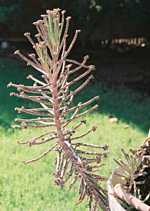
Photo: Cathy Sue Hawkins 2003 |
Left: K. delagoensis (K. tubiflora)
An almost indestructible Kalanchoe that propagates by forming plantlets on leaf lips. These drop off and root in any nearby plantpot, so it is almost impossible to lose the clone. This plant grows up to 5 ft tall and produces an attractive cluster of orange flowers at the top of its stem.
|
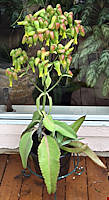
Photo: Sandy Crider 2016 |
Left: Kalanchoe pinnata cv. Magic Bells
A newish name for a cultivar of Kalanchoe pinnata with a spectacular head of large greenish grape-like bracts from which emerge orange-tipped flowers. The flowering head is long-lived as the green bells persist after the flower is finished. The leaves tend to produce plantlets on their margins and these can be used for propagation.
Native to Madagascar but naturalised in many tropical countries. As with other Kalanchoes, leaves contain toxic bufadienolides and must not be fed to livestock.
|
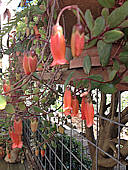 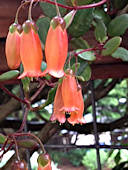 Photos: Lonna Richmond
Kalanchoe uniflora Raymond-Hamet 1910
Syn. Bryophyllum uniflorum (Stapf) A. Berger 1930
This epiphyte has thin trailing stems with quite fleshy, succulent ovate leaves. The inflorescence is a cyme produced at leaf axils along the stems, with one to three individual bright orange-red tubular flowers.
Native to Northern Madagascar, growing in heaths and forests at altitudes of 3000 to 6500ft. Not frost hardy but excellent for hanging baskets and for the milder temperate garden.
|
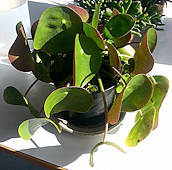
Photo: Bob Downie 2015 |
Left: Pilea peperomioides
One of the few truly succulent members of the genus Pilea.
Makes an undemanding shade-tolerant houseplant.
|
 |
| |
|
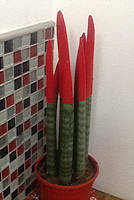
Photo: John Longfield
|
Left: Sansevieria Velvet Touchz® Red
This is a Sansevieria cylindrica whose leaf-tips have been dipped in red pigment as a marketing gimmick. Other colours are available. I have no idea what the red material is, if it will harm the leaves or if it is water soluble. It might wash off if you put your plant out in the rain in mild weather. Obviously, any new leaves that grow will not have the red marking so given time the plant will naturally revert to all-green leaves.
Personally, I can't understand anyone disfiguring a lovely architectural succulent plant like this, or why doing so would make it more marketable.
|
 |
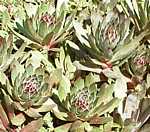
Photo: Sandy Jacques, Pennsylvania, Spring 2003 |
Left: Sempervivum (L. always living)
Common names: Houseleeks, Hens and Chicks
These mat-forming succulents come in a range of colours and forms, are generally hardy through a cold-wet Winter, yet provide an exotic look to patio planters and temperate gardens.
See: The Sempervivum Page for more information and a wider range of Sempervivums.
|
 |
| |
|
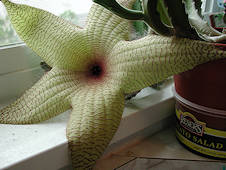
Photo: Sally Jordan 2003
|
Left: Stapelia gigantea N.E. Brown 1877
This stem succulent has large flowers with a perfume of rotting carrion designed to attract blow flies as its natural pollinator.
Native to South-Eastern Africa.
|
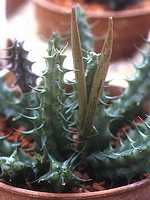 |
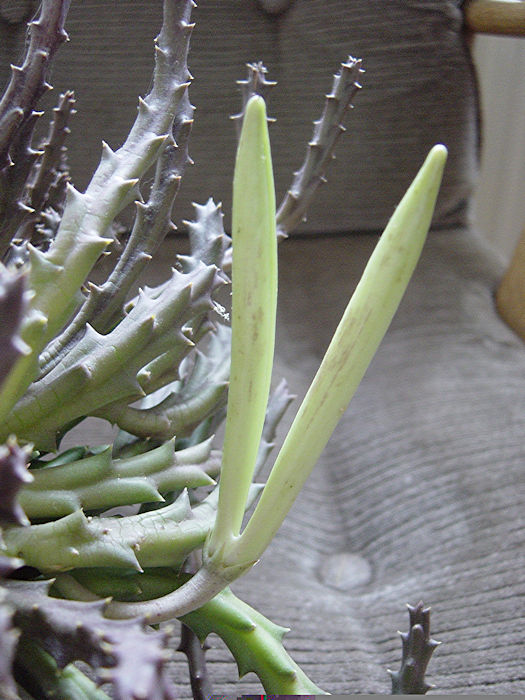
Photo: Jan Gielkens 2004 |
Left: seed horns
These are not flower buds but seed horns on these Stapeliads. Fertilised flowers of Asclepiadaceae typically produce a pair of seed pods. The seeds within are packaged with a mass of silky parachutes to aid wind dispersal.
|
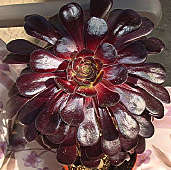


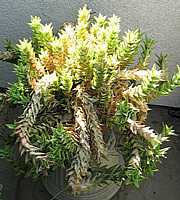











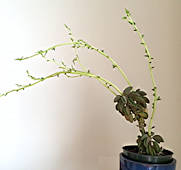
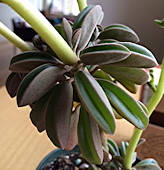





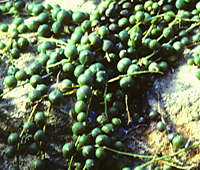
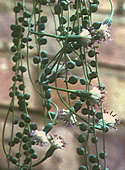





 search if you can guess the family, species or common name of your succulent. It is surprising how many images of obscure plants can be found on the internet. However, beware of inappropriately named images. Look for a concensus on names with several images. Then do an image search on that species name and see if most of the pictures are similar to your succulent plant.
search if you can guess the family, species or common name of your succulent. It is surprising how many images of obscure plants can be found on the internet. However, beware of inappropriately named images. Look for a concensus on names with several images. Then do an image search on that species name and see if most of the pictures are similar to your succulent plant.











